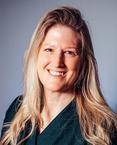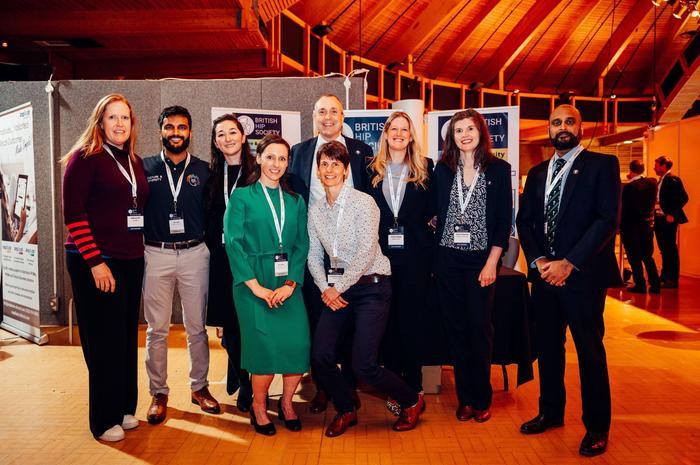Representation, inclusion and effecting change: Culture and Diversity at the British Hip Society
Authors:

Joanna Maggsa

Jonathan Howellb

Vikas Khandujac
aConsultant Orthopaedic Surgeon at Torbay and South Devon NHS Foundation Trust and BHS Culture & Diversity Chair
bConsultant Orthopaedic Surgeon at Princess Elizabeth Orthopaedic Centre, Royal Devon and Exeter Hospital and Past BHS President
cConsultant Orthopaedic Surgeon & Research Lead (Elective) at Addenbrooke's Hospital, Cambridge and BHS President
Corresponding author e-mail: [email protected]
Scanning the room at the British Hip Society (BHS) annual meeting in 2019, it was difficult not to be struck by the uniformity of the audience; there were almost no women. Women have comprised majority of medical students for over 25 years1, but only 7% of trauma and orthopaedic surgery consultants are women2 (the lowest of any surgical speciality) and only a very few of these choose to subspecialise in hips.
Is this an important failing? Evidence tells us unequivocally that it is. Both experimental and real-world data demonstrate that teams comprising members from diverse backgrounds, with a broad range of experiences, perform much better than homogeneous teams3. And consider the wealth of talent that we, as a profession, are failing to harness, if we only appeal to potential future surgeons from a narrow selection of the whole pool. Having surgeons from a diverse range of backgrounds improves the access to, and experience of, care for patients from marginalised or underrepresented groups4-7. The observation that homogeneity in medical and surgical teams can negatively affect the care given to populations, underlies the conclusion of the Ottawa 2010 conference that “specialist training should aim to produce a workforce whose make up reflects the population it serves”8.
The BHS leadership recognised this failing and the urgent need to address the lack of diversity in our organisation. We needed to understand why women, and those from other underrepresented groups, were not choosing careers in hip surgery. What barriers were they facing? And what strategies could we use to minimise these barriers, or remove them completely? We put out a call for interest, and the BHS Culture and Diversity Committee was born.

Current projects
i) Membership survey
Challenge number one was understanding what underpins our lack of diversity. We wanted to quantify how many surgeons from under-represented groups we had in our membership, and to ask all our members about their experiences of, and perceptions about, barriers that may exist in our professional lives. We teamed up with CARD group (Belfast, UK), to design and deliver a questionnaire that would deliver the insight we were hoping for. The full results of our survey were sent to the BHS membership and presented to the Annual Scientific Meeting in 2021; they are due to be published shortly. Some particularly striking themes are worth noting here though, as they directed our early efforts. Firstly, we found that most of our members said they had not themselves experienced barriers to career progression. A similar majority tended to say that they didn’t think that barriers existed to for others. However, women and those from other underrepresented backgrounds were much more likely to report having experienced barriers, and therefore knowing them to be potential deterrents to career progression. Secondly, we were interested (and a little saddened) to find out that several respondents reported a feeling of professional and social exclusion from the Society. We decided to start by understanding and breaking down barriers to career progression for underrepresented groups, and by becoming a more open and welcoming society.
ii) Mentorship
It was clear that a lot of those experiencing barriers felt they were navigating these alone. We wanted a mechanism through which people could share these experiences and support one another, which would also contribute to a sense of connectedness, camaraderie, and community. A mentorship scheme seemed a good place to start, particularly as mentorship had been highlighted as an important step in diversity initiatives in both the Royal College of Surgeons of Ireland PROGRESS report7 and the 2021 independent review on diversity and inclusion for the Royal College of Surgeons of England, led by Baroness Helena Kennedy QC9.
In setting up our scheme we were generously supported by Emma Causer and the team at the award-winning Plan B mentoring10, who shared their abundant expertise with us. We recruited mentors through direct invitation, through our newsletter and through a social media campaign. All mentors were provided with four hours training in mentorship and coaching skills. This was delivered by Karen Picking, a leadership development consultant from an independent organisation with expertise in healthcare settings. We then ran mentor-matching events, during which mentors and mentees met for 12 - 15 minutes for an informal discussion in Zoom breakout rooms to see who they established good rapport with, and with whom they could envisage building a useful mentoring relationship. Pairings were made and mentorship began! We have just delivered our third round of mentor training and are about to host our fourth mentor-matching event. We are now in the process of gathering feedback so that we know how to develop and improve the scheme in the future.
The call for mentors was extremely heartening and we have been very touched by the experiences that people are willing to share. Have a look at our mentorship page https.britishhipsociety.com/bhs-mentors and you will find surgeons offering to discuss: the challenge of operating whilst pregnant, being Black, or gay, or 5'3 in orthopaedics, feelings of isolation, combining clinical practice with research, dealing with exam failure, supporting colleagues through adoption, retraining, returning to work following illness, changing course mid-career, the culture shock faced by international medics, following non-training pathways, addressing sexual harassment and bullying, and managing the pressures of training and practicing when the world outside work feels like a complete mess.
iii) Amplifying marginalised voices
As part of our effort to understand barriers faced by our colleagues, we collaborated with the British Orthopaedic Association (BOA) to host a webinar with Yvonne Coghill. Yvonne is Director for Workforce Race Equality, NHS London, having previously held the position of Director for the Workforce Race Equality Implementation Team, NHS England/Improvement. She talked passionately about barriers experienced by those from under-represented ethnic backgrounds, implicit bias, and frank racism. The talk was well-received, and we hope to run similar events in the future.
iv) Role models
Stereotypical characterisation of orthopaedic surgeons and a macho orthopaedic culture contribute to some people rejecting it as a career possibility11. A memorable paper in the Christmas BMJ described Orthopods as “as strong as an Ox and twice as clever”12. Curleweis et al.13 asked medical students with no personal experience in trauma and orthopaedic surgery, what they felt about it as a profession. Assumptions were that it is 'aggressive' and 'sexist'. These attitudes need challenging.
Work by Michelle Ryan, Professor of Social and Organisational Pyschology and Director of the Global Institute for Women's Leadership, has suggested that one reason why women don’t pursue careers in male-dominated professions is that when they look at the career hierarchy they don’t find anyone to identify with in senior roles, and can’t imagine themselves fitting in14. Social media campaigns such as #Ilooklikeasurgeon have already started to try and change the image of surgeons and provide new role models, taking on board the idea that you 'have to see it to be it'. We have built on this, aiming to creating a new narrative about what orthopaedic surgeons look like and how we behave. We have started by recording short video biographies of surgeons from different backgrounds, discussing what it is they love about their work as a surgeon, where they have experienced challenges, and what they have done to overcome these. These videos are due to be shared through our social media channels in coming months.
v) Addressing manels
In orthopaedic surgery, there is a propensity for expert panels to feature only men15. This not only reinforces the damaging stereotypes discussed above, but continues to contribute to a system that “structurally affords certain groups rights and privileges above others”16. Psychological studies have found that, being asked by peers to contribute professional expertise (known as positive distinctive treatment) correlates with good in-group status and is important for confidence and ambition and a sense of belonging17. We need to ensure that such opportunities are shared fairly. At this year’s BHS Annual Scientific Meeting we focused on ensuring that a wider range of experts were invited to chair sessions and share their experience on panels. 40% of our chairs and panellists at this year’s meeting were women.
vi) Inclusion
Learning from the findings of our survey, we were determined to make our annual meeting a more friendly and welcoming environment. We held our second dedicated Culture & Diversity (C&D) main podium session, highlighting our initiatives and inviting people to become involved. We also had a C&D stand within the trade fair, where we asked attendees to share their thoughts and suggestions with us, in exchange for smoothies and popcorn! We provided free places for medical students, as well as a family room, from which two babies were able to watch the presentations, and where their parent surgeons had access to space, changing facilities and an endless supply of tea and coffee. To break down social barriers we also hosted our first ever Fun Run, which was fantastically well attended despite a 06.45 start, and deservedly won by a surgeon in a duck outfit!
Future projects
i) School engagement
Whilst there may be increasing awareness of the underrepresentation of women and some ethnic groups in orthopaedics, this is not the case for all under-represented groups. Surgeons from working class backgrounds, for example, comprise only a small percentage of orthopaedic consultants. Clearly this is an issue with root causes that take effect well before medical school recruitment. How do we ensure that children from less wealthy backgrounds, with the intelligence and skill to become the next generation of orthopods, find out about our profession early enough to consider aiming to join it? To address this, we are planning to start running workshops in state schools, to introduce children to the possibility of a career in surgery, and to help signpost them through the application process.
ii) Implicit bias training
This year we also aim to offer implicit bias training, with recognised CPD points, to all our members.
iii) Podcasts
Following our successful Yvonne Coghill webinar, we are planning a series of podcasts thinking about the challenges to diversity, and how to overcome these, and championing the vast amount of work that is now being done in this area from grassroots projects to international initiatives.
iv) Forum
In June we will be running our first Culture and Diversity forum. This will be an open access event with the aim of ensuring that all surgeons feel equally included in our society, and our profession. Anyone with an interest in improving the culture of orthopaedics and the diversity of orthopaedic surgeons is welcome. You do not have to be a BHS member. Please come and along and hear about our projects, volunteer your support, and pitch your own ideas, which we could support or help to take forward!
These initiatives and activities would not have been possible without the enthusiasm, hard work and vision of our excellent C&D committee. The BHS C&D Committee includes the following members: Kathryn Dayananda, Sarah Eastwood, Marieta Franklin, Naomi Gibbs, Kate Gill, Prof Amy Grove, Sam Hook, Jonathan Howell, Sam Jain, Shivam Kolhe, Joanna Maggs and Samantha Tross.
References
- Moberly T. Number of women entering medical school rises after decade of decline. BMJ. 2018;360:k254
- Hedley Newman T, Parry MG, Zakeri R, Pegna V, Nagle A, Bhatti F, et al. Gender Diversity in UK surgical specialities: a national observational study. BMJ Open. 2022;12(2):e055516.
- Syed M. (2019). Rebel Ideas. John Murray Press.
- Tsugawa Y, Jena AB, Figueroa JF, Orav EJ, Blumenthal DM, Jha AK. Comparison of Hospital Mortality and Readmission Rates for Medicare Patients Treated by Male vs Female Physicians. JAMA Intern Med. 2017;177(2):206-213.
- Baumhakel M, Muller U, Bohm M. Influence of gender of physicians and patients on guideline-recommended treatment of chronic heart failure in a cross-sectional study. Eur J Heart Fail. 2009;11(3):299-303.
- Gomez D, Haas B, de Mestral C, Sharma S, Hsaio M, Zagorski B, et al. Gender-associated differences in access to trauma center care: A population-based analysis. Surgery. 2012;152(2):179-85.
- The Royal College of Surgeons in Ireland (2017). PROGRESS: Promoting Gender Equality in Surgery. Report of the Gender Diversity Short Life Working Group. Available at: https://cdn.ymaws.com/womensurgeons.site-ym.com/resource/resmgr/docs/Resource_Library/20170707051740_Gender-Divers.pdf.
- Prideaux D, Roberts C, Eva K, Centeno A, McCrorie P, McManus C, et al. Assessment for selection for the health care professions and speciality training: consensus statement and recommendations from the Ottawa 2010 conference. Med Teach. 2011;33(3)215-23.
-
The Royal College of Surgeons of England (2021). An independent review on diversity and inclusion for the Royal College of Surgeons of England. Available at: www.rcseng.ac.uk/about-the-rcs/about-ourmission/diversity-review-2021.
-
Plan B. Creating greater diversity on boards. Available at: www.planbmentoring.com.
-
Bellini MI, Graham Y, Hayes C, Zakeri R, Parks R, Papalois V. A woman's place is in theatre: women's perceptions and experiences of working in surgery from the Association of Surgeons of Great Britain and Ireland women in surgery working group. BMJ Open. 2019;9(1):e024349.
-
Subramanian P, Kantharuban S, Subramanian V, Willis-Owen SAG, Willis-Owen CA. Orthopaedic surgeons: As strong as an ox and almost twice as clever? Multicentre prospective comparative study. BMJ. 2011;343:d7506
-
Curleweis K, Thornhill C, Leung B, Hamilton L, Ricketts D, Rogers B. The effects of sex, race and the hidden curriculum on medical students’ career choices: lessons for orthopaedics. Bulletin. 2020;102(6):e7-e11.
-
Peters K, Ryan M, Haslam SA, Fernandes H. To Belong or not to Belong: Evidence that Women’s Occupational Disidentification is Promoted by lack of fit with Masculine Occupational Prototypes. Journal of Personnel Psychology. 2012;11(3):148-58.
-
The Conversation (2020). What’s wrong with ‘manels’ and what can we do about them, 14th October 2020. Available at: https://theconversation.com/whats-wrong-with-manels-and-what-can-we-do-about-them-148068.
-
Bekker S, Ahmed OH, Bakare U, Blake TA, Brooks AM, Davenport TE, et al. We need to talk about manels: the problem of implicit gender bias in sport and exercise medicine. British Journal of Sports Medicine. 2018;52:1287-9.
-
Begeny CT, Huo YJ, Smith HJ, Ryan MK. Being treated fairly in groups Is important but not sufficient: The role of distinctive treatment in groups, and its implications for mental health. PLoS One. 2021;16(5):e0251871.
